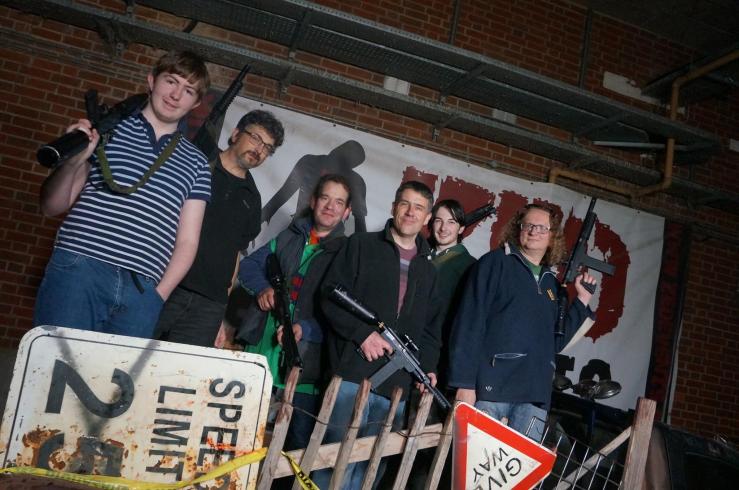Last weekend, I found myself running up and down stairs in a disused shopping mall in Reading, getting chased by, and shooting zombies. To celebrate a friend’s fiftieth (and mine, as my friends clubbed together to buy ticket as a present for my upcoming big birthday) we were participating in an immersive experience run by Zed Events.
Gathering at the appointed time around the back of the mall by an unassuming door, the ten of us met with fellow players who’d booked in smaller groups, pairs or even on their own. We were briefed by a Zed Events employee, with some very clear out-of-game rules, mostly about health and safety (don’t punch the zombies) but also reminding us that the zombies were actors and that we must not use personally offensive language (though they assured us that screaming “Fucking Die! You Zombie Bastard” is not personally offensive).
But then they opened the door and we were welcomed into the diagesis, the game-world. We were greeted by employees of Centesis, as volunteers for a flu drug trial. We signed disclaimers (real) and the official secrets act (not real), locked our personal possessions (phones, keys, coins) away and were being briefed when the alarm went off and everything went dark.
I don’t want to spoil the story for those that might want to participate, but I can share this video, from Zed Events’ site:
Did you watch it? All that running around in the semi-dark, not quite knowing what was going on? It’s exactly like that.
I’ve mentioned players, but it’s not actually much of a game. There are always enough of you around to shoot a zombie before they catch you, none of the player characters are in any peril. You don’t even risk the temporary death and re-spawn of a video game. There are a few escape room style puzzles, but nothing as challenging as you might find in a real escape room.
The emotional engine driving this experience is presence. It is the immersive, dark atmosphere, the limited range of vision, the pathetic torches that some of have, the feel and weight of the guns we carry, that enables our suspension of disbelief.
The story structure is effective as well. I won’t spoil it for you, but you’ll guess it encompasses a military experiment gone wrong, and a limited time to escape before a special ops team comes to destroy the evidence, including us. But within the confines of zombie-lit, Zed Events know how to raise the tension: the group works together at first, then is split in two, each with a security guard to help us, but in the final act, we are split into even smaller groups, and forced into exploring the darkness on our own. There is a Big Bad too, an unkillable armoured Zombie called … Martin.
The division of play/fear affect in my own emotional responses were at odds but in an intriguingly constructive way, at the same time I found my self screaming “Run! It’s Martin!” while the other half of my brain was inwardly grinning at the playful absurdity of the situation. I had great fun.
It’s it worth the money? It’s not cheap, but if you can afford it, it’s worth doing, especially if you are prepared to get into character.
